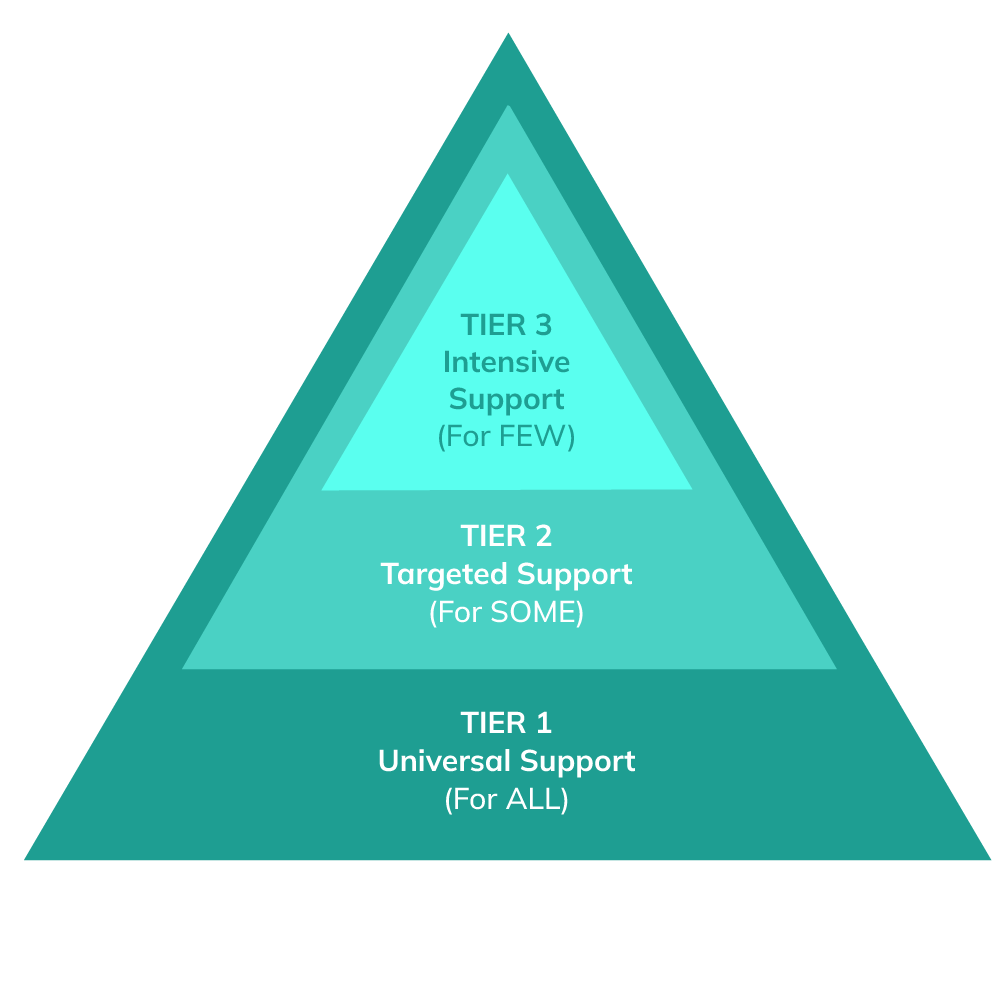Investing in the people and systems that support youth mental health.
We’re strengthening the systems, staff, and partnerships needed to deliver effective, accessible, and sustainable behavioral health support for all children and youth in our schools.

Enhancing Knowledge and Skills
SLO County’s approach to capacity-building, under the CYBHI, is to equip adults, students, and families with the knowledge and skills they need to promote mental wellness and academic success. We're doing this by weaving these supports directly into schools through something called a Multi-Tiered System of Support (MTSS). This means mental health and well-being aren't separate, but rather a core part of the whole school environment, ensuring everyone in the school community has access to the support they need.
Through CYBHI, SLO County schools and districts deliver services across three tiers:
- Tier 1 (Universal Supports): Support for Everyone. Creating a positive school environment for all students, with preventive measures like lessons on well-being, building important social-emotional skills, relationships and strategies to encourage expected behavior across the entire school.
- Tier 2 (Targeted Supports): Extra support for some. Offering additional resources and guidance for students who need additional support with their behavior or mental health. Targeted strategies designed to address specific needs, often in a group setting.
- Tier 3 (Intensive Supports): Individualized care for a few. Licensed clinicians and credentialed staff provide one-on-one, specialized care for students with more complex needs.

How We’re Supporting the Implementation of Integrated Systems
Team-based leadership structures.
Selection and use of evidence-based interventions.
Ongoing coaching and systems-level support.
Data-driven decision making and continuous improvement.
Building Collective Capacity and Best Practices through Practitioner Networks
-
SLO County Counselor Network
A P-12 collaborative of school counselors focusing on mental health, student well-being, and academic success.
-
Behavior Support Network
A community of school-based behavior professionals working on positive behavior strategies and inclusive learning environments.
-
SLO SEL Community of Practice
Includes educators, childcare providers, and community partners committed to promoting SEL and wellness.
Comprehensive Training and Professional Development
Integrated Systems Implementation
We help school and district leaders bring together all the pieces for a positive school environment. This means we train and coach teams to create a unified system that supports students’ academic, social, behavioral, and mental well-being – the whole package. Our approach uses a framework called Multi-tiered System of Support (MTSS). Think of it as a roadmap that helps school & district teams organize and use proven methods to improve outcomes for all students.
Building on Positive Behavior Supports and Interventions (PBIS) as a starting point, schools then layer in social-emotional learning (SEL), trauma-informed practices, and restorative practices. This allows each school to build a support system that truly fits its unique community and culture.
Tier 1
Youth Mental Health First Aid:
Introduces participants to the unique risk factors and warning signs of mental health problems in adolescents, builds understanding of the importance of early intervention, and teaches individuals how to help an adolescent in crisis or experiencing a mental health challenge. Mental Health First Aid uses role-playing and simulations to demonstrate how to assess a mental health crisis; select interventions and provide initial help; and connect young people to professional, peer, social, and self-help care.
Safe Spaces: Foundations of Trauma Informed Practice for Educational and Care Settings
Free, online training designed to help individuals working with children and youth recognize and respond to signs of trauma and stress, provide mindsets and strategies to respond, and help create the conditions for safe and supportive learning environments.
Developing Habits of Effective Classroom Practice
Supports classroom teachers to improve the culture and climate in their classrooms. Focused on designing an emotionally and physically safe learning environment, establishing clear expectations and predictable routines, using engaging strategies for learning, encouraging expected behavior through feedback, and responding to behavior errors instructionally.
Restorative Practices for Educators
Proactively building healthy relationships and a sense of community with students, teachers and staff to prevent and resolve conflict and wrongdoing through accountability and repairing harm.
Tier 2
Bounce Back & CBITS:
Evidence-based interventions designed for school-based counselors or other licensed mental health clinicians aimed at relieving symptoms of Post-Traumatic Stress Disorder (PTSD), depression, and general anxiety among children exposed to trauma or stressful life events.
Bounce Back Non-Clinical and SSET
Evidence-based interventions for nonclinical school staff (e.g., teachers, behavior specialists, certified wellness coaches) to deliver evidence-based group interventions aimed at supporting students who have been exposed to a stressful life event, teaching coping skills through a series of group sessions.
Restorative Conflict Intervention
Supports staff to view and respond to others during conflict with dignity and respect in order to restore relationships and improve future communication. Participants learn how to facilitate a Restorative Conference when significant harm has occurred.
Applied Suicide Intervention Skills Training (ASIST)
Equips participants to recognize and respond to signs of suicidal ideation and develop safety plans with those at risk.








